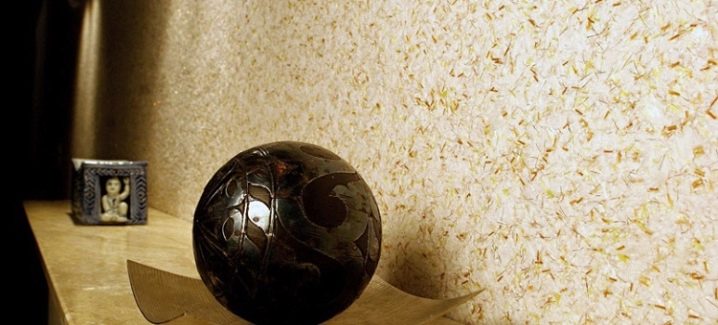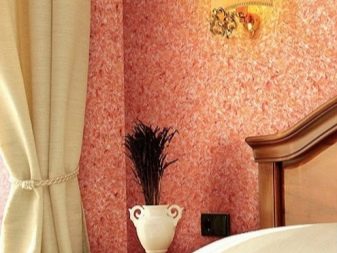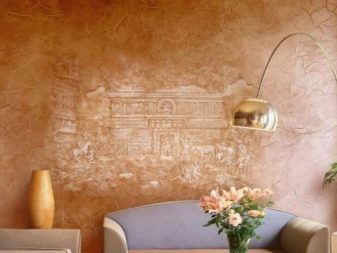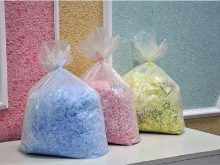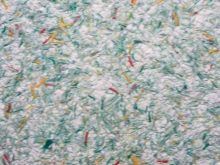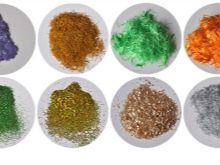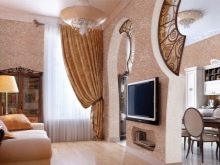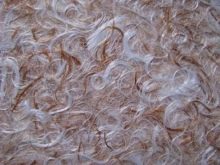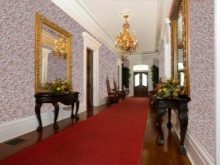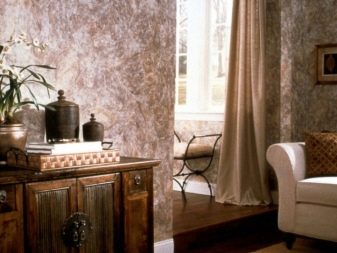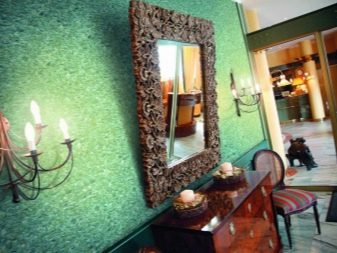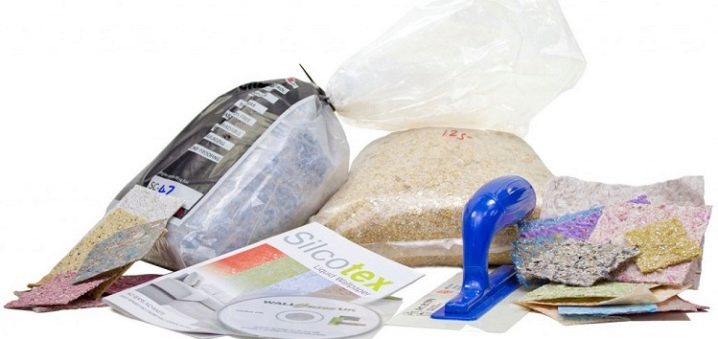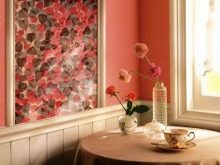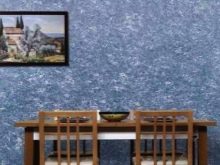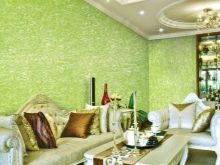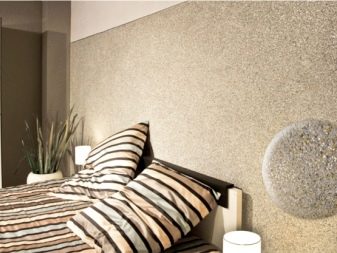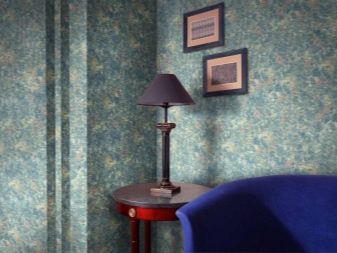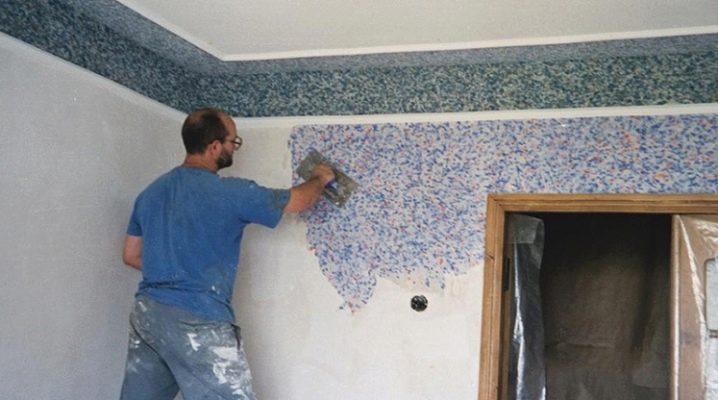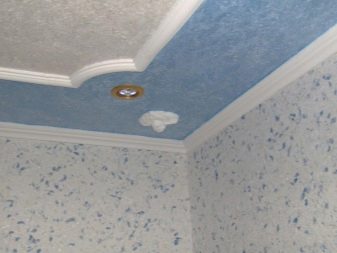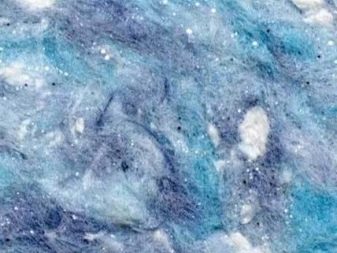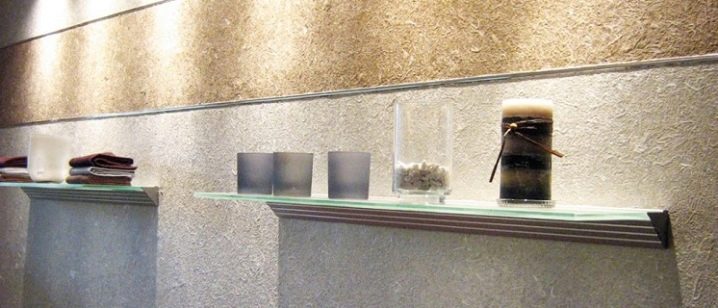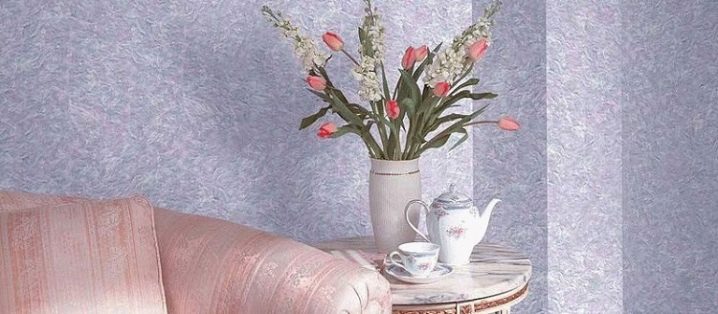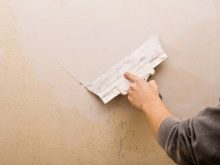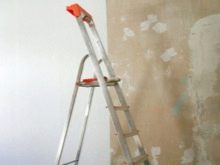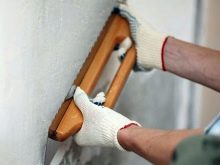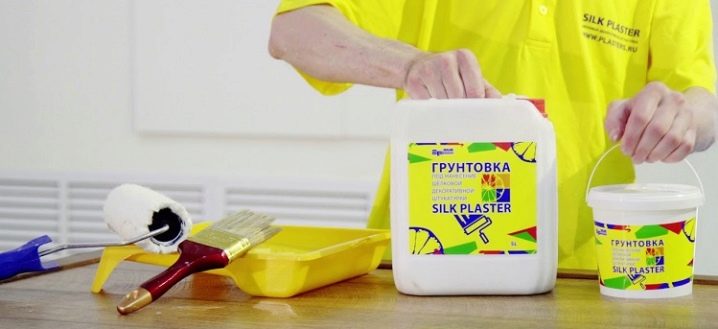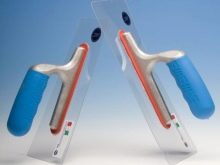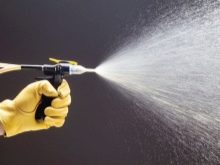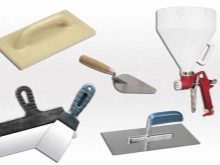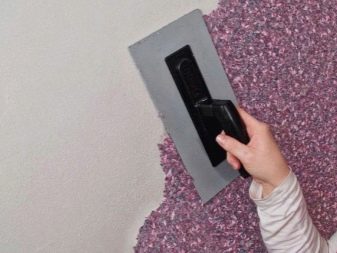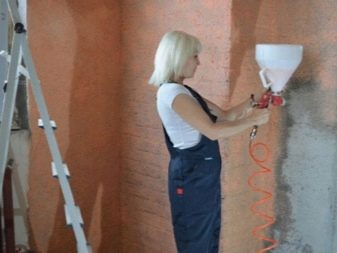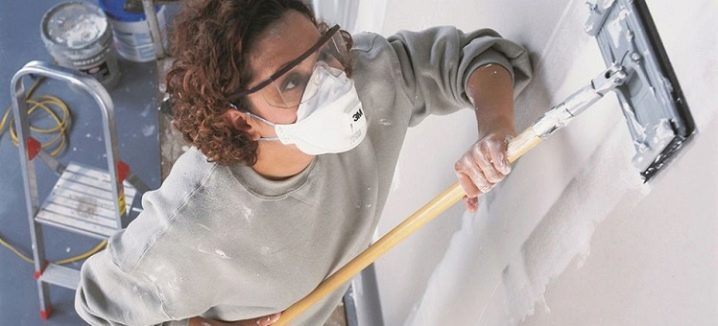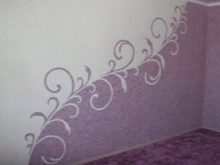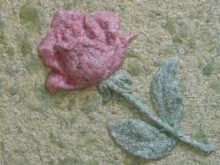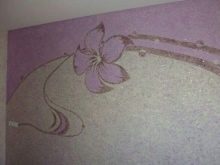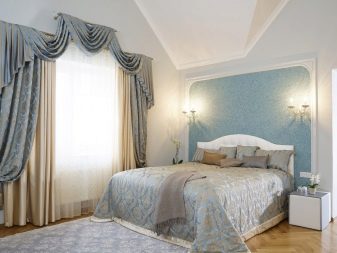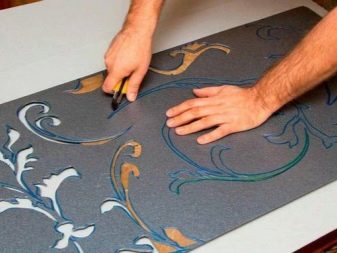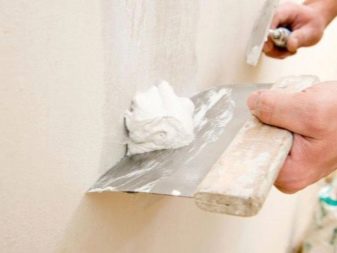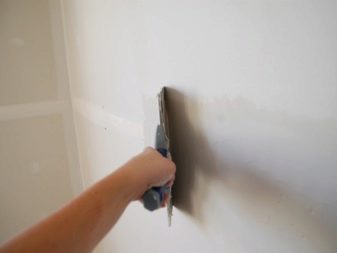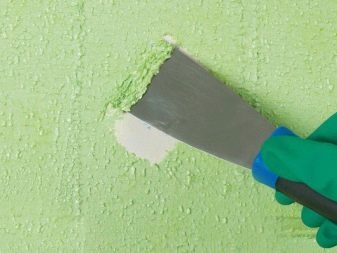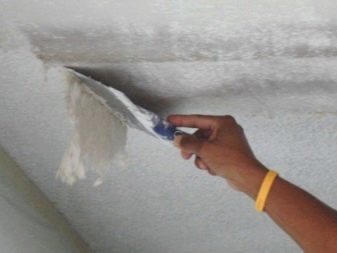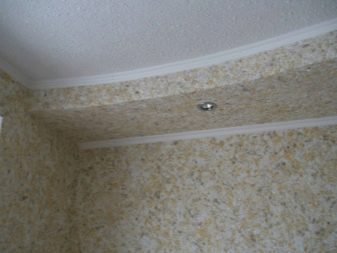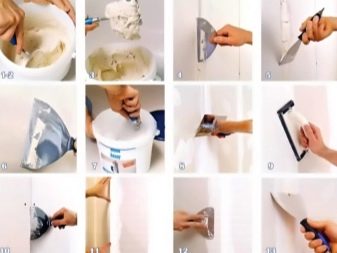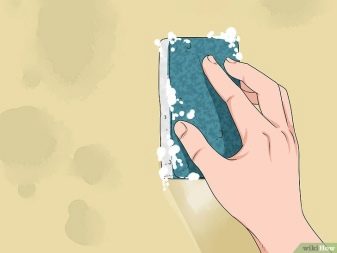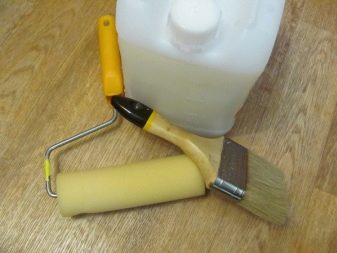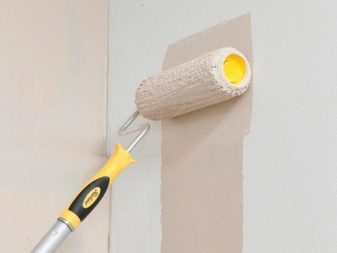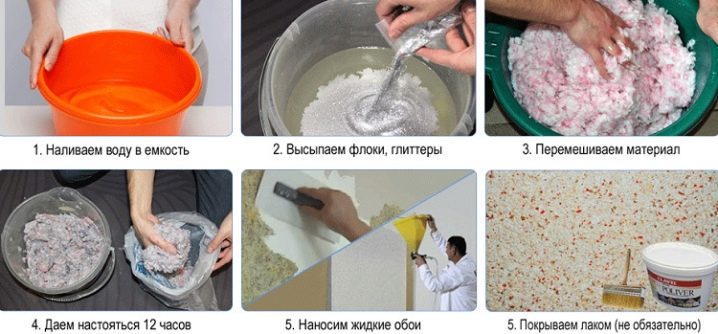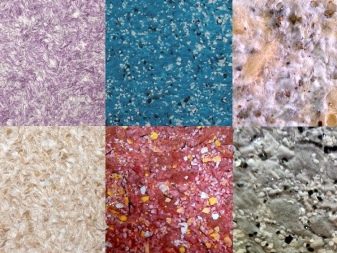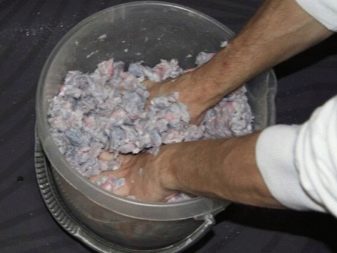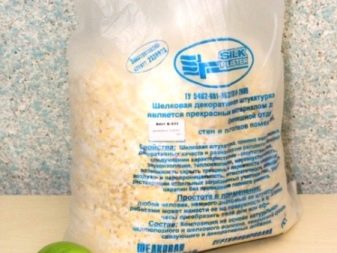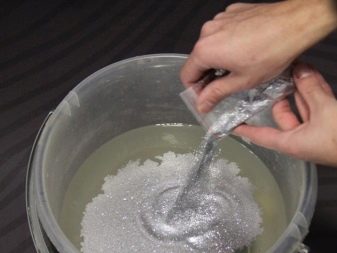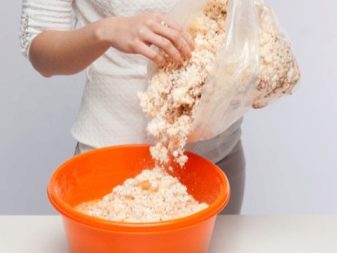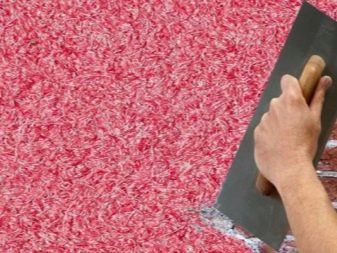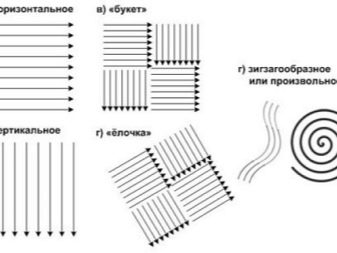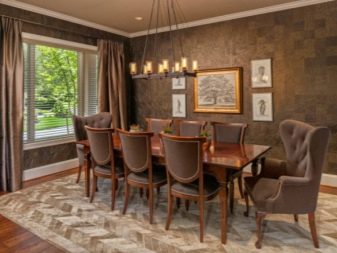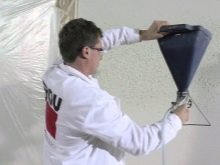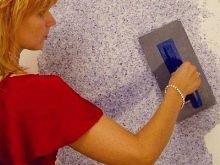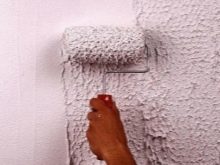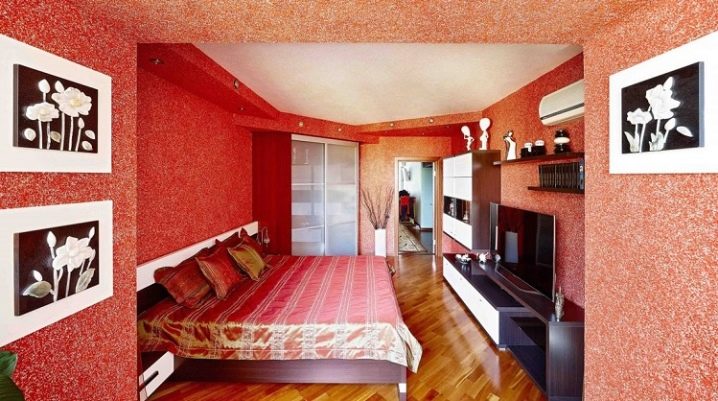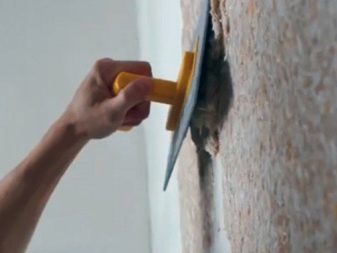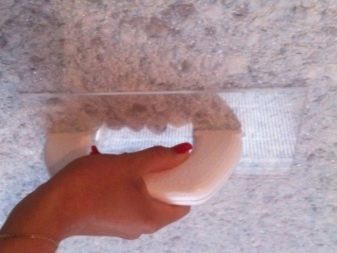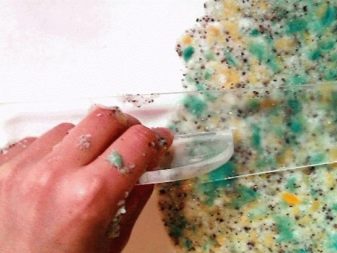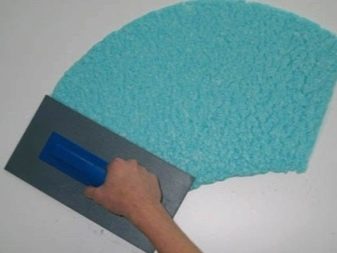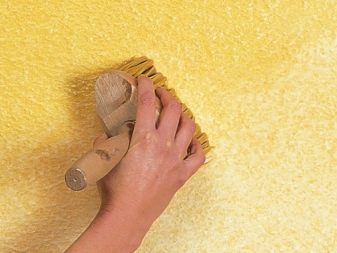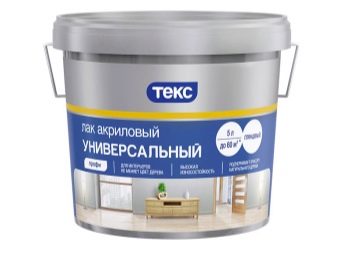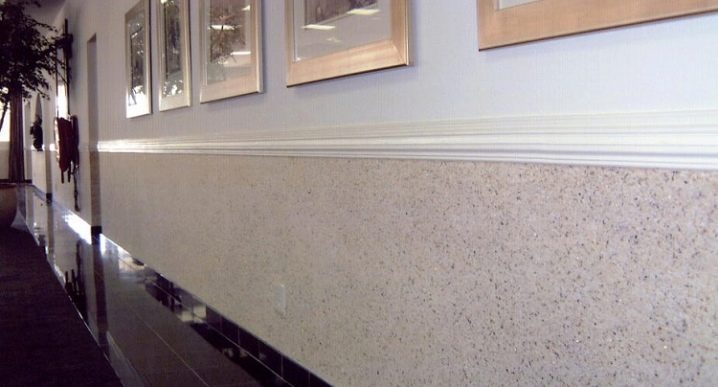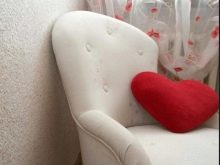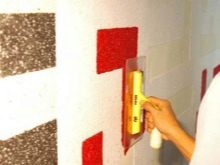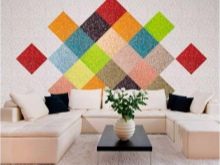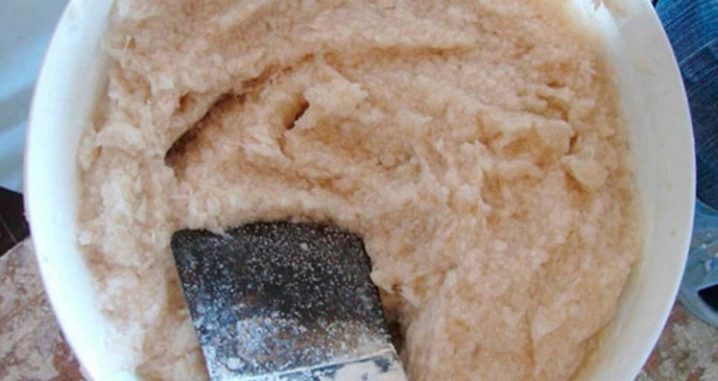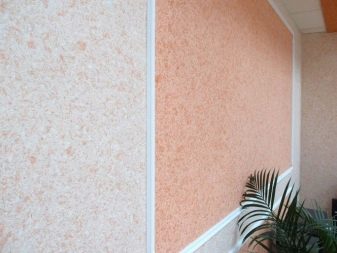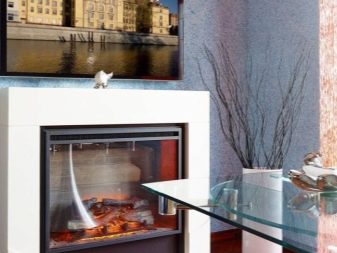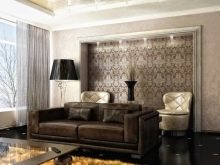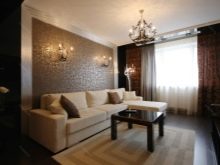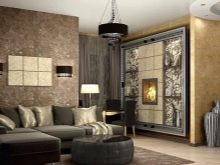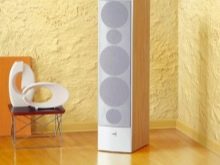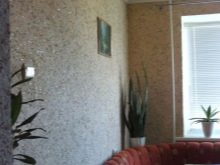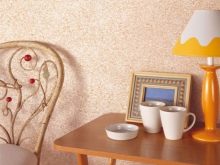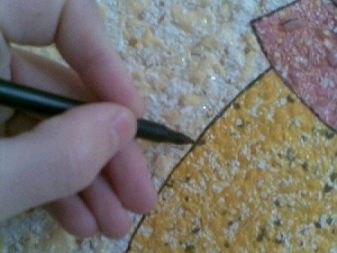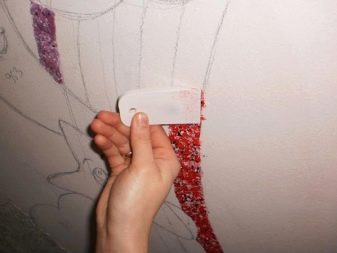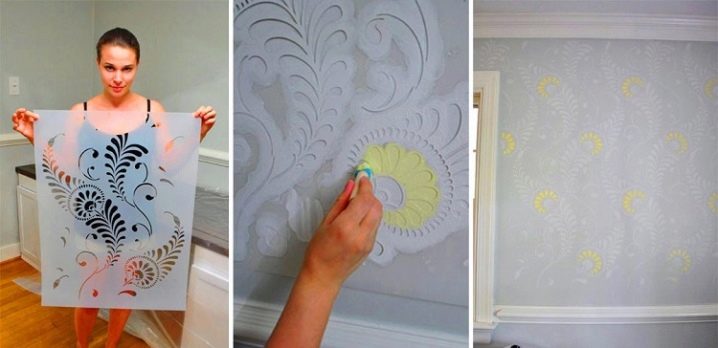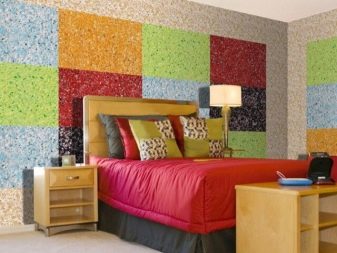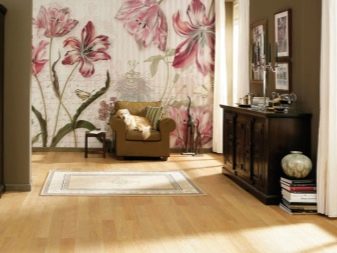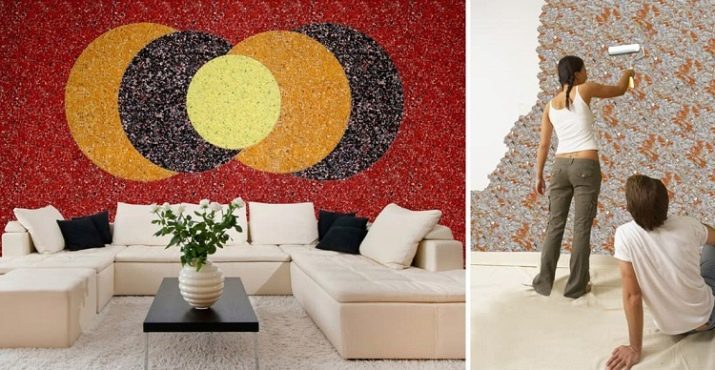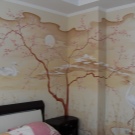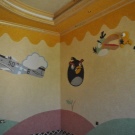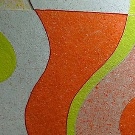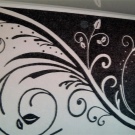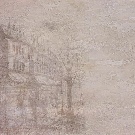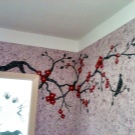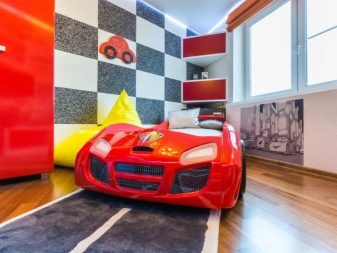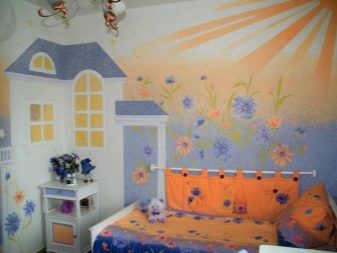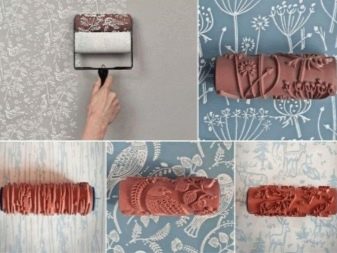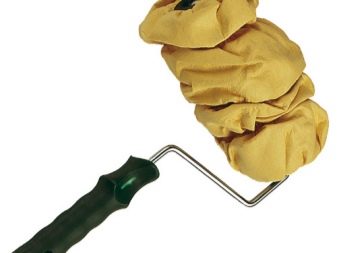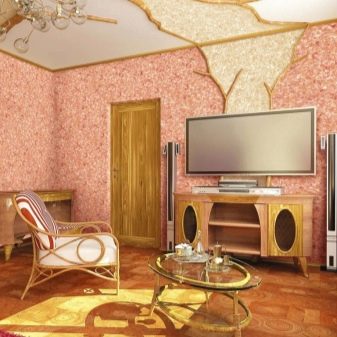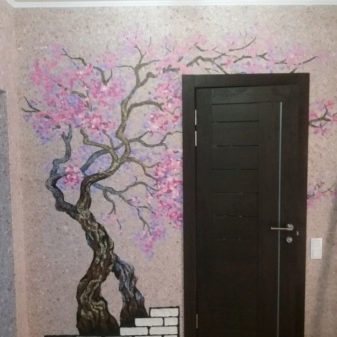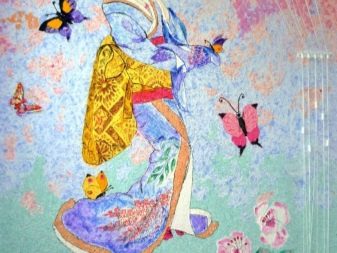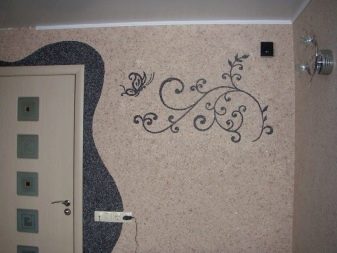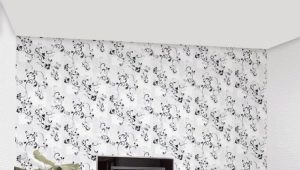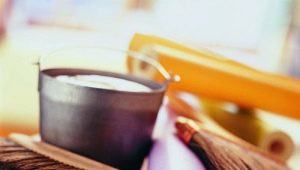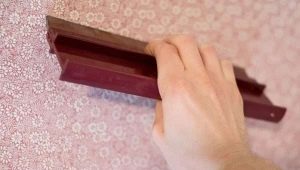How to apply liquid wallpaper on the wall?
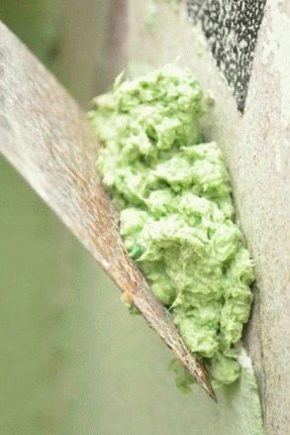
Facing walls with liquid wallpaper is different from the typical method of pasting vertical planes rolled analogs. Liquid wallpaper is a unique material of the new generation, through which you can decorate the walls in a different style.
To understand how to properly apply liquid wallpaper on a wall, you need to know the characteristics of the material, its strengths and weaknesses, the method of preparation, the appropriate types of planes to be processed, the ways of gluing, the finer points of decoration.
What is it and how to work with them?
It is a mistake to confuse liquid wallpaper with plaster: they do not have sand or plaster in their composition, although the method of applying both materials is similar.
Liquid wallpaper is a packaged material on a different basis, which is divided into two types:
- Powder - a kind similar to peculiar flakes or sawdust impregnated with a special glue substance;
- "Wet" - raw materials, produced in the form of a finished mixture that does not need to be adjusted.
More often the weight of packages makes 1 kg. However, trademarks often, by reinsuring, add to the indicated weight about 10% of the additive, thereby allowing to achieve the correct consumption of the raw material of the finished mixture per 1 sq. Km. m and attracting the attention of buyers that their material is enough to process the wall more than that of other companies. The composition of the material determines its type.
In addition to the content in the liquid wallpaper, cellulose, cotton fibers, acrylic, lavsan, they include:
- binding components (organic or polymeric glue);
- fungicides (antiseptic substances that prevent the formation of an environment for the appearance of fungus and mold);
- plasticizers (components to facilitate the application and uniform distribution of the material on the treated planes);
- dyes (pigments to give the desired shade);
- decorative inclusions (marble crumb, colored flock, mica scales, glitter and mother-of-pearl).
Materials are colored, ready for decorating walls of different shades of a color palette, and white, which are provided for lining for painting.
All varieties are subject to a strict classification, according to which they are divided into:
- Cellulose - materials with a predominance of paper (a budget type of lining, which has a shorter service life, low resistance to mechanical damage and moisture, a simpler appearance);
- Silk - wallpaper, which contains silk fibers, which changes the aesthetic perception of the finished finish (durable and beautiful wallpaper that is resistant to sunlight);
- Mixed - the “golden mean” between paper and silk varieties, a balanced formula that incorporates the best properties of paper and premium appearance of silk wallpapers.
The liquid wallpaper mass is unique in that it provides for a change in color, the addition of different inclusions, which can be bought separately in order to give the texture of individuality.
It is easy to work with this material, but it’s a painstaking task that doesn’t stand in a hurry, otherwise the view of the walls risks getting messy. It is important to observe the same layer of application: so the surface of the wall will look monolithic.
Both dry mix and wet wallpapers provide for the same material consumption on the surface to be treated. Usually one package is enough for facing 3 - 4 square meters. m plane. This allows you to perform a preliminary calculation in order to buy a sufficient amount of material and not save money, trying to mask the planes with a layer of minimum thickness. However, the flow rate is conditional and may vary depending on the type of tool used for the application.
Advantages and disadvantages
In order for the lining to be beautiful, practical and appropriate for the purpose of a particular room, you need to know the strengths and weaknesses of the material. In liquid wallpaper mass of advantages:
- they are made of high-quality raw materials on professional equipment in accordance with a correctly calculated formula of components, which ensures high quality characteristics of the material;
- stand out favorably against any roll analogs,differing in seamless technology of drawing on the vertical planes, having a pleasant volume texture and original appearance;
- in addition to strengthening the walls, they are excellent thermal insulation, which is especially noticeable during the cold season;
- at the expense of a larger layer of thickness (from 2 to 6 mm) they provide sound insulation for walls, saving the household from annoying extraneous sounds from neighboring apartments;
- Regardless of the chosen shade, method of decoration, as well as accepting the accentuation of the space, make the walls elegant, giving the space a homely atmosphere;
- they are not limited in choosing the method of decorating a plane, creating any pattern with regard to the chosen style, placing it anywhere on the wall, taking into account the location of the furniture;
- they do not need careful preparation of the walls, it is even better for them if the walls are rough, because this contributes to better adhesion of the material to the working surface;
- do not roll off vertical surfaces during lining, do not splash, lie down well, do not peel off after drying;
- they are an eco-friendly type of wall covering, harmless to human health, do not emit toxins into the air, do not have a strong odor;
- allow adjustment of damaged areas, quick disassembly in case of contamination, without needing to completely remove all facing material;
- have a mass of useful performance characteristics: refractories, do not accumulate dust on the surface, do not fade under the action of sunlight, do not change their properties with temperature drops.
Liquid wallpaper can decorate the walls of different rooms. They are appropriate in decorating the walls of the bedroom, nursery, study, home library, hallway, corridor, living room, toilet room. Apply them easily.
This does not require special skills, and the lining allows for minor fixes of the décor by re-applying. If the design allows, this material decorates the ceiling area, emphasizing the desired part of the plane.
However, when making a special texture, it is important not to overwhelm the mass with an abundance of decor (sparkles, mother-of-pearl, marble chips): this does not have the best effect on the texture, complicates the lining, uniform mixing of inclusions, highlighting the drawbacks of the mixture on the wall.
Minuses
With a lot of advantages, liquid wallpaper is not without drawbacks. This finishing material:
- it looks beautiful and status in expensive silk varieties, which with a large amount of work can be expensive;
- it is afraid of moisture, therefore it needs processing of the finished dried surface with vapor-permeable acrylic varnish, which preserves the air exchange of the finishing material;
- not always appropriate in rooms with high humidity (not suitable for decorating the kitchen, loggia, bathroom, balcony);
- does not have a diverse palette of shades, so you have to experiment with the selection of the desired tones by means of coloring pigments, using part of the raw material for the samples, reducing the total amount of material from the package;
- unstable to dirt, therefore, in the presence of oily stains and dirt, it needs to be glued to the problem area, which is often noticeable due to the difficulty of selecting the right shade with the correct amount of pigment and additional inclusions;
- It is undesirable to use in houses with high humidity, which can provoke dampness of the finish.
In contrast to the rolled varieties, before finishing this raw material, a control batch is made, because the actual material needs may differ from the calculations made.This allows you to determine the layer and method of application to a specific type of surface.
Surface features
Liquid wallpaper are unpretentious material cladding.
They fit perfectly on:
- drywall without putty;
- various wood surfaces and plywood;
- concrete wall;
- OSB stove;
- fiberglass (glass);
- plaster;
- cement, brick stone surfaces;
- shell rock.
Preparing the walls, it is important to know: it is impossible to perform high-quality cladding, if the walls have remnants of old paint (oil or water-based). The material will not stay on such surfaces as it will not be possible to finish the walls on the old whitewash, planes with greasy and oily stains.
All this will have to be removed, otherwise the wallpaper will fall off quickly enough, since in each case the degree of adhesion is minimal. You should not experiment with clapboard: it has stitches, which is undesirable for liquid wallpaper, because during operation the integrity of the coating can be broken. For the same reason, it is unacceptable to put them on the tile.
What is needed?
To glue the walls with liquid wallpaper, you need to take care of related tools.The desired inventory depends on the method of applying the material. It is divided into basic tools and accessories for decoration.
Standard set may include:
- capacity for cultivation or adjustment of ready mix (giving of color, gloss);
- sparse pile paint roller for material distribution;
- toothed roller to give the finish the desired texture;
- hopper (a special spray gun for uniform application of a thin layer);
- plastic trowel (rectangular-shaped paddle for material collection and distribution);
- rubber spatula (either made of plastic for smearing the material on the working surface).
You should not buy all the tools: if the plane to be processed is large, you should choose a spray gun, having chosen a large nozzle for it. When decorating walls with a single-color material, it is easier to use a paint roller. If you plan to decorate the surface in different colors, the main working tool will be a spatula.
In addition to the main set, you should take care of the presence of a medium-sized brush: with its help, you will have to trim the different levels of lining by wetting the instrument in water.
It is easier for some to replace the brush with a special plastic float, controlling the process of smoothing the fibers of the wallpaper. If dry powdered wallpaper is bought, it is worth buying a respirator in order to prevent the penetration of hygroscopic particles of wallpaper into the body during the mixing process.
Auxiliary materials through which liquid wallpaper get decor, include stencils.
Depending on the chosen idea of stylistics, features of the drawing, they are divided into 4 types:
- Monochromatic - templates used for finishing the finished plane in the same color;
- The individual components of a single composition are stencils for step-by-step decor, in which the finishing layers overlap each other;
- Bulk - types used with putty for texture, increasing the level of the trimmed plane by a few mm;
- Anti-patterns - stencils that create the effect of light (decorating not the pattern, but the background).
Depending on the type of decor you are planning, you may need moldings, a baguette or a regular ceiling plinth. With their help, the composition is often enclosed in a frame, creating the effect of a panel or a unique picture.Wallpaper decor can be used after drying a monochromatic surface or during lining.
Stencils can be purchased at a hardware store or prepared by yourself, printing it out on a printer, gluing it to a thick cardboard and cutting out the necessary forms. If you have artistic skills, liquid wallpaper allows a lot of possibilities for design: you can draw a draft of the picture directly on the wall with a pencil, then apply the finish itself.
Training
After the material is purchased, stencils are prepared, the design is selected, you can proceed to the preparation of working surfaces.
Despite the fact that the material is not demanding on the ideal flatness of the walls, it is important to consider some rules:
- walls must be strong, without noticeable drops and large potholes;
- the moisture absorption capacity of the planes should be minimal;
- noticeable cracks, chips should be covered with a putty, leveling the surface and ridding it of tubercles;
- it is undesirable to sand the walls: this will cause a decrease in adhesion, the wallpaper needs a surface roughness;
- the surface should be uniform: it will be easier to perform the lining;
- the color of the wall must be white, otherwise the color of the lining may be damaged, giving the tone of the base with unsightly stains on the general background.
To prepare the walls for lining, you can use this instruction, which consists of several stages:
- Initially, the surface is eliminated from old wall coverings, removing everything that can later peel off;
- the surface must be flat: it removes existing nails, screws, screws (any protruding metal or plastic object);
- after that, the surface is brought to the level, getting rid of visible slopes and irregularities of the walls, thereby reducing the consumption of material for alignment (if the hole is large, it may eventually differ in color);
- working with drywall, process the entire surface, otherwise even minor defects may be visible after finishing;
- after leveling the walls or partitions with gypsum putty with the addition of PVA glue, they should be removed with a vacuum cleaner;
- after getting rid of the dust, it is necessary to prime the walls using a deep penetration primer (for better adhesion, the walls are primed twice with a break between surface treatment at 3 o'clock).
If, in addition to the walls, the ceiling is planned to be processed, the preparation of this plane is carried out in the same way. After the surface is dry, liquid wallpaper can be applied to the walls.
It is unacceptable to impose a finishing material on a polished surface without additional processing: to glue this finish to construction dust will not work. If you ignore oil stains, over time, liquid wallpaper in their place will blow up. When pasting metal surfaces in these places, rust spots are not excluded.
If the surface of the walls is too smooth and polished, it is important to give it a uniform roughness before applying the liquid wallpaper. This applies to concrete and woody treated planes. In this case, the preparation of surfaces is carried out with a primer with quartz dust. If you do not give the plane roughness, liquid wallpaper can roll in the process of pasting.
It is easy to make such a composition: you need to add quartz or marble dust to a usual deep penetration primer. If not, you can use quartz sand. This primer composition will reduce material consumption, make the coating layer uniform, avoid tearing and skipping of wallpaper in the pasting process.
How to breed?
Preparation of liquid wallpaper depends on the type of raw material (dry component or the finished mixture). In the work there is no need to use gloves: the composition of the material does not irritate the skin. Regardless of the type of raw materials, whether wet or dry varieties, they must be soaked with water at a temperature not exceeding 30 degrees.
Despite the fact that in some cases you have to thoroughly stir the mass with your hands, getting rid of lumps, the process is not complicated. Often the components of the future mass are packed separately; they need to be combined, stirred and diluted with plain water.
Preparation of finishing material consists of several stages:
- while the liquid wallpaper is in the package, they are well shaken: this is necessary to improve the fine structure (so when mixing there will be fewer smaller lumps);
- the finishing material is placed in a large container (8 l) with high edges (at least 30 cm high), adding components (including color) to it, varying the degree of saturation of the hue, the amount of gloss;
- the mass is stirred with the hands, trying to make it fluffy, eliminating the uniform and evenly dyed while stirring;
- after giving the material uniformity, warm water is added to it and kneaded (it is impossible to use a mixer even at minimum speed: so you can crush the reinforcing long fibers);
- the amount of water must match the specified in the attached instructions on the packaging of a specific type of wallpaper (usually 5 liters);
- after soaking the mass with water, it is placed in a bag, tightly closed, and allowed to stand for a period of time indicated on the package (usually 6 to 12 hours): the glue should soften and bind the fibers.
Each time no more than one package is kneaded: it is impossible to combine the two, as this will complicate the preparation of the wallpaper.
At the same time it is impossible to divide the kilogram package into parts: if you prepare the finishing in parts, while doing the tinting in the same shade, you can not guess with the tone, which will deprive the facing of solidity. In addition, the fragmentation of the mass into parts is fraught with violation of the required proportions, and the wallpaper may differ in consistency.
After the material is ready, you can combine the liquid wallpaper of the same tone in a large capacity by stirring. This will eliminate the difference in material, get rid of color transitions.
Ready liquid wallpaper does not mix in two cases:
- if they are different colors;
- if they glue adjacent walls.
In the second case, you can add the rest of the raw materials to the new portions of the second wall. For practical reasons, it is better to make a small supply of liquid wallpaper: it is even better if there are residues left after the finish. If in the future it becomes necessary to correct the problem area, it will be possible to use ready-made raw materials of a similar shade and texture.
Preparation of the working solution must be carried out correctly, according to the method indicated on the packaging. This will allow the material to be uniform, keep on the surface of the walls for up to 15 years or more.
How to glue?
This type of finish is unique in that it can be glued in different ways. Variants of the application of mass depend on the author's ideas.
You can perform wall cladding:
- horizontally;
- vertically;
- zigzag lines;
- in a spiral;
- in the form of "Christmas tree"
- method of "bouquet" (in different directions).
This decoration will allow, without using a pattern, to give the surface a light, unique pattern, which is often better than the ornament and will demonstrate the individuality of the lining.
Drawing
The technology of applying liquid wallpaper to the surface of the walls depends on the tool used. Each of them differs in its consumption:
- using a spray gun, material consumption will be minimal;
- rolling wallpaper through the roller consumption will be moderate;
- performing the manual cladding method will have to spend more material.
Proper performance of work involves the finishing of the planes in natural daylight. However, in reality this is rarely possible, so you should take care of additional lighting, which is fixed to the side relative to the working plane. This will allow you to better see the uniform deposition of the layer of material and all possible defects in the form of bumps, pits, level curvature.
Liquid wallpaper is applied to the wall in separate portions, gradually spreading the mass over the planes, each time adding a new portion to the edges of the lining. If there is no experience of such finishing, you should start sticking from the place that will be subsequently closed with furniture. So you can understand how best to work with unusual material.
Immediately it is worth considering that with a lack of experience it may not be enough to finish several walls of one day. This factor is important: between portions of the wallpaper can get joints, noticeable in level and density of application.
To finish the walls with liquid wallpaper looked as professional as possible, you should listen to the rules of experienced craftsmen:
- the material is applied to the surface of the walls evenly, not exceeding a layer thickness of 2-3 mm, while tightly filling all areas of the base so that it does not shine through the lining;
- when using a spatula, it is held at an angle of 20 degrees relative to the working surface, having a slight pressure on the tool (with strong pressure, the surface of the wallpaper will not have the texture, and the flow rate will increase significantly);
- It is unacceptable to delay, otherwise joints may be obtained in the work, I add each portion to the already treated surface, smoothing the material in the direction from the empty wall to the filled area;
- so that the paste-like mass of the wallpaper does not peel off from the wall by sticking to the trowel or spatula, you can wet the tool with plain water;
- When performing docking places near a molding, baguette or ceiling plinth, proceed with the utmost care: removing the dried lining neatly and imperceptibly is quite problematic;
- if during the process the mass lags behind the surface to be treated, which indicates insufficient preparation of the walls with a primer, it is necessary to slightly dilute the mass with water and mix;
- so that the joints between the wallpaper are not visible, you can moisten the surface with a spray gun, after softening, walk along the joints with a roller or spatula (this will soften the material, make the surface evenly rough, equalize the different levels and transitions).
Finishing walls with water does not eliminate visible defects, therefore, it is necessary to glue the material initially beautifully. Once the walls are covered with liquid wallpaper, they are given the opportunity to dry. The approximate drying time is indicated on the packaging of a particular material; it varies somewhat from different manufacturers and depends on the temperature conditions in each particular case.
Liquid wallpaper can dry for several hours, if the room is hot, and up to three days, if it's cold. After that, in order to improve the practical properties of the material, the entire area of gluing is treated with a special acrylic lacquer, applied in 1 or 2 layers with a roller.
Varnish should be applied to the surface properly, drying each layer. If the decor was designed in the form of sparkles, you can not add them to the wallpaper: it is better to mix them with varnish, so the gloss will be more pronounced.
Professional Tips
In the process of gluing the walls with liquid wallpaper was not difficult, you can note a few useful recommendations:
- if the prepared solution is thick enough, you can dilute it with a small amount of water, bringing the mass to a pasty state;
- do not use hands: there is a trowel for this. Any work encourages accuracy, while saving on a simple tool will increase the facing time;
- if a colored lining with the addition of color is provided, mixing of the portions of wallpaper before the immediate finish is necessary;
- buy facing material with a small margin: if you don’t miss it, you will not be able to pick up an identical tone, saturation with mother of pearl, glitter or marble chips (take raw materials with a margin of 10–15% of what is needed);
- performing drawings with liquid wallpaper, it is important to consider that they are applied to a dried background or separate (not adjacent) fragments of the pattern, otherwise it will not be possible to get a flat expressive line;
- the distribution of wallpaper on the working surface is at eye level: shifting up or down can lead to the appearance of a wave or fossa
How to store leftovers?
In most cases, after pasting the walls with liquid wallpaper, some excess raw material remains in the container. Do not throw it away and worry about the extra spending. Liquid wallpaper can be stored up to adjustments after a few years. However, in order to make the raw material suitable, it will have to be completely dried, without closing the container. After that, for storage, the wallpaper is shifted to a dry bag, tightly closed and cleaned to fit.
In this case, you can put a spare bag on the one in which the material itself is located: over time, dust accumulates on any surface, which can be removed along with the first bag.
It is unacceptable that it gets into the correction portion of the material: this way wallpaper can change its shade and stand out against the general background with a grayish patch.
Surface restoration
If during operation a greasy stain or contamination appears on the surface of the wall, it is possible to quickly and effortlessly make corrections. To do this, take the rest of the mixture, dilute it with warm water to obtain a pasty consistency and set aside soften, engaged in removing the old coating.
Then proceed according to a small instruction:
- the problem area required replacement, moisten with water with a brush or spray;
- Wallpaper neatly separated from the wall using a metal spatula or construction knife;
- the base of the wall is treated with a primer using a small brush;
- after drying the primer, the edges of the patch are sprayed with water;
- put mass, gently adjusting the material under the joints;
- after drying the wallpaper, the area is sprayed with water to align with the main wall;
- if the lining was previously treated with varnish, it is applied to the patch.
The use of varnish on top of finishing work allows you to simplify the maintenance of wallpaper: so they can be wiped with a damp sponge or cloth.
Design options
The use of liquid wallpaper in the decoration of the walls of rooms is different and depends on the taste preferences of the owners of the house. Someone enough to decorate the walls with plain colored wallpaper, limiting them at the top and bottom of the plinth. For individuals who are inclined to creative experiments, there is not enough of one background: they correctly use liquid wallpaper without depriving the interior of practicality and excellent aesthetic perception.
Design techniques for decorating walls with liquid wallpaper provide several ways to change the space:
- accentuation of the room’s perspective features (underlining protrusions, niches, columns, panels, bay windows, arches, giving out the construction drawbacks for the merits of the room);
- selection of a specific space by creating the appearance of a panel, a painting, a protrusion (for example, trimming a part of a plane in the form of a large rectangle, framing it in a molding frame);
- changing the mood of a room through a pattern lined with colored paints on a large part of the wall, using the techniques of the influence of color shades on the mood and well-being of a person.
By themselves, the liquid wallpaper on the walls look unusual and volume. Each shade of their changes the perception, making the space light airy or solemn, pompous.
In addition to the original originality, they are unique in that they can be decorated in different ways.
There are three techniques for performing the pattern:
- by means of special acrylic paints and felt-tip pens on the dried surface of white color;
- method of filling voids using stencils;
- by spreading the mass of the desired shade onto each separate fragment of the pattern.
Each method is unique in its own way and allows you to create a special design that matches the capabilities of the wizard. In the first case, it is drawing on the finished lining. It is laborious, since it does not have the ability to perform expressive and clear lines along the canvas itself.
Fill relief wallpaper with colors so simple: it is necessary to paint the entire structure of the material, which requires patience and perseverance.
The use of stencils is done in two ways: you can impose ready-made templates directly on the finished wall, performing a peculiar ornament, delimiting the surface, or a chaotic pattern. In the second method, stencils are used at the moment of distribution to the surface.
More often they are applied to the wall, encircled the contours with a pencil, then they remove and fill the necessary voids with their wallpaper color. The application of the third method differs from the second method of drawing a picture. It is carried out without templates, drawing directly on the wall with a simple pencil. If there are no drawing skills, you cannot do without templates.
Drawings
The most interesting and beautiful themes of popular patterns created by liquid wallpaper are:
- single branches with falling foliage;
- monophonic and colorful fluttering butterflies;
- Egyptian ornaments;
- simple geometric shapes;
- large flowers and leaves in the form of stylization;
- various curls and wavy lines.
Drawings with liquid wallpaper have found wide application in decorating the space of children's rooms. However, they do not always look beautiful. The reason for this is the inept approach to decorating and the aggressive theme of the pattern, which can frighten the child and influence the wrong perception of the surrounding world.
Since the wallpaper near does not give sharp contours, the drawings are often large, which reduces the usable area, and instills a sense of insignificance in the child. In addition, the strange characters depicted on the walls, do not teach good ("Engry Birds", "Sponge Bob").
Light stylized drawings are considered to be successful design techniques. They do not overload the interior of the room, can be located in open places, decorated with frames, be an unobtrusive accent of space, emphasizing a certain style. A unique method of decorating walls is the application of liquid wallpaper on the wall by means of a special figured roller with a pattern.
This lining can create a seamless wallpaper with any print, and the pattern can be made in the same tone as the background, giving it texture, or in contrast with it. For this, the material is gathered onto a roller and rolled from top to bottom along the wall surface.
The decoration of the wall with wallpaper is carried out taking into account the furnishings: if there are many details of furniture, the drawing should be simple and easy. If the room is spacious and does not have an abundance of accessories, you can decorate the whole wall with a pattern, correctly choosing colors to match or contrast the furniture, decor of the central and auxiliary lighting. The area of the room to be plastered also matters: the smaller it is, the more modest the drawing should be.
Beautiful examples in the interior
Liquid wallpaper in the design with the transition to the ceiling looks stylish, unusual and beautiful, having support in the form of decorative wood branches: when performed in a beige and pale coral shade, they give depth to the space, complemented by furniture of light brown tones.
Gentle, elegant wall decoration looks wallpaper wallpaper with a pattern of sakura trees: brown trees with pink petals stand out against the gray wall, while having support in the tone of the doors and doorway.
Emphasizing the protrusion on the background of a single-color wall is a great idea that can be beaten with two shades of the same color: due to the versatility of the tone and the uniqueness of the texture, the interior seems voluminous, even if the ceiling and floor covering are decorated with glossy materials.
Using a stylized vegetable theme, you can equip the play corner of the children's room: you can make drawings over a plain plane, accenting a small rack with shelves in the form of a brown tree trunk.
Using Asian themes and having professional drawing skills, you can decorate one of the walls with a unique geisha pattern, making smooth color transitions around the pattern and adding fluttering butterflies to the overall background.
The white door, which merges with the light tone of the cladding material, can be accentuated by contrasting gray-colored wallpapers, highlighting the doorway with a curly line (you can also mark doors leading to the balcony, kitchen, bathroom), repeating the contrasting trim in the form of a small lace pattern.
How to apply liquid wallpaper, see the next video.
